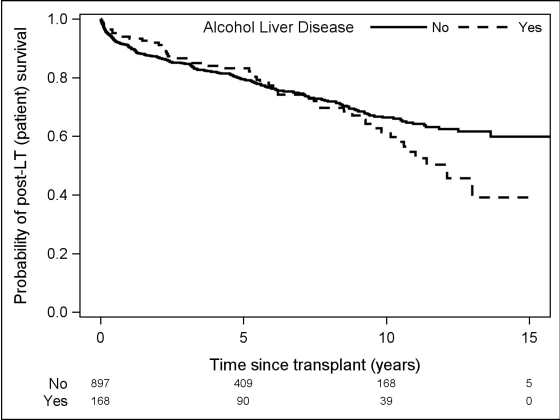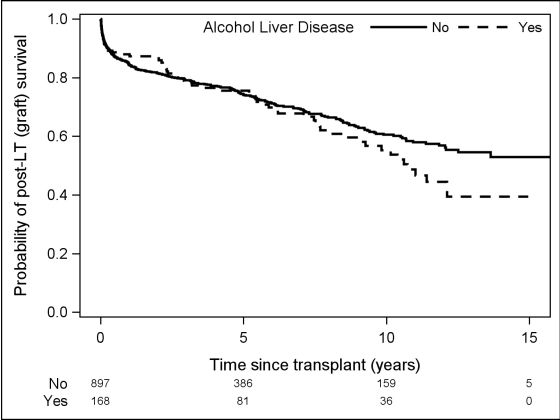Living Donor Liver Transplantation for Alcoholic Liver Disease: Data from the A2ALL Study
Surgery, University of California, San Francisco, San Francisco, CA.
Meeting: 2018 American Transplant Congress
Abstract number: 554
Keywords: Alcohol, Liver, Liver transplantation
Session Information
Session Name: Concurrent Session: Liver: Living Donors and Partial Grafts
Session Type: Concurrent Session
Date: Tuesday, June 5, 2018
Session Time: 4:30pm-6:00pm
 Presentation Time: 5:18pm-5:30pm
Presentation Time: 5:18pm-5:30pm
Location: Room 608/609
The literature on living donor liver transplantation (LDLT) for alcoholic liver disease (ALD) is primarily from single Asian centers. We investigated LDLT outcomes for ALD from the Adult-to-Adult Living Donor Liver Transplantation Study (A2ALL).
A2ALL recipients who underwent LDLT between April 1998 and January 2014 were reviewed. We compared recipients with ALD and non-ALD using Wilcoxon rank sum and chi-squared tests; graft and patient survival were estimated using Kaplan-Meier methods.
1065 recipients were included. 168 (15.8%) underwent LDLT for ALD; the majority were male (70.8%), Caucasian (92.7%), median (IQR) age 53.3 (47.5-59.0) years, BMI 26.2 (23.2-29.5), and MELD 15 (13-19). 94.6% of recipients received a right lobe graft, 70.8% of recipients were biologically related to their donor. Compared with recipients who underwent LDLT for other indications, those with ALD had a greater proportion of male recipients (70.8% vs. 55.9%, p<0.001) and concomitant HCV diagnosis (44.6% vs. 36.6%, p=0.048). Between ALD vs. non-ALD, there was no significant difference in median number of complications (3 vs. 3, p=0.75), rejection (8.4% vs. 11.1%, 0.39), HAT (5.8% vs. 7.5%, p=0.48), bile leak (28.6% vs. 27.8%, p=0.85), or biliary stricture (32.5% vs. 33.3%, p=0.84). Patient survival was similar for ALD and non-ALD recipients at one (94% vs. 91%), five (83% vs. 79%), and ten (61% vs. 66%) years post-transplant (p=0.32). There was no difference in graft survival between ALD and non-ALD recipients at one (88% vs. 84%), five (76% vs. 74%), or ten (55% vs. 61%) years post-transplant (p=0.29).
We found no significant difference in major complications, patient survival, or graft survival among patients transplanted for ALD versus other etiologies of liver disease.
CITATION INFORMATION: Braun H., Dodge J., Grab J., Syed S., Roll G., Freise C., Roberts J., Ascher N. Living Donor Liver Transplantation for Alcoholic Liver Disease: Data from the A2ALL Study Am J Transplant. 2017;17 (suppl 3).
To cite this abstract in AMA style:
Braun H, Dodge J, Grab J, Syed S, Roll G, Freise C, Roberts J, Ascher N. Living Donor Liver Transplantation for Alcoholic Liver Disease: Data from the A2ALL Study [abstract]. https://atcmeetingabstracts.com/abstract/living-donor-liver-transplantation-for-alcoholic-liver-disease-data-from-the-a2all-study/. Accessed January 5, 2026.« Back to 2018 American Transplant Congress


